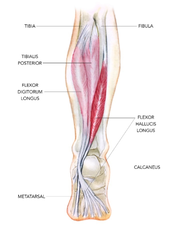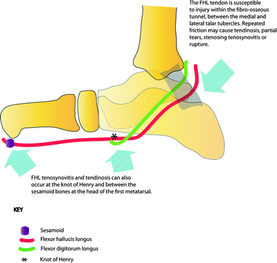 Do you feel pain or clicking in the back of the ankle joint and/or big toe joint with pointing the foot? Is it painful to tendu, releve, plie, or go en pointe? If so, it may be attributed to flexor hallucis longus (FHL) dysfunction. This is a common overuse injury seen in dancers and is often referred to as “dancer’s tendinitis” (Wentzell, M). The FHL plays a major role in foot/ankle stabilization and balance on pointe and demi pointe. Because the FHL muscle crosses two joints, its demands are up to three times higher than that of single joint muscles (Wentzell, M), making the joint especially susceptible to overload with repetitive pointe work, releve, and extreme ranges of plantarflexion. The FHL muscle originates on the posterior fibula. It passes under the medial malleolus through a fibroossues tunnel (green arrow on the far right of the image below), intersects with the flexor digitorum longus tendon (middle arrow), and passes between two sesamoid bones before attaching to the undersurface of the big toe (left arrow). During pointe work, the FHL tendon can be directly compressed as it passes through these points. Compression or entrapment at any of these sites can lead to pain and injury to the tendon. This can be the result of overuse or poor technique en pointe. Treatment
Returning to dance after an FHL injury should be gradual. Focus on mastering the basics of your technique. With early diagnosis and treatment, this can be managed to facilitate a quicker recovery and smooth return to dance. References: 1)Wentzell, M. (2018). Conservative management of a chronic recurrent flexor hallucis longus stenosing tenosynovitis in a pre-professional ballet dancer: a case report. The Journal of the Canadian Chiropractic Association, 62(2), 111. 2) Rowley, K. M., Jarvis, D. N., Kurihara, T., Chang, Y. J., Fietzer, A. L., & Kulig, K. (2015). Toe flexor strength, flexibility and function and flexor hallucis longus tendon morphology in dancers and non-dancers. Medical problems of performing artists, 30(3), 152-156. Photo credits: 1) https://www.sportsinjurybulletin.com/the-flexor-hallucis-longus/ 2) Chew N.S., Lee J., Davies M., Healy J. (2010) Ankle and Foot Injuries. In: Robinson P. (eds) Essential Radiology for Sports Medicine. Springer, New York, NY. https://doi.org/10.1007/978-1-4419-5973-7_3
1 Comment
1/8/2024 03:03:31 am
Reference health websites:
Reply
Leave a Reply. |
CategoriesAll Cross Training Injury Prevention Nutrition Recipes Wellness Archives
October 2021
|

 RSS Feed
RSS Feed